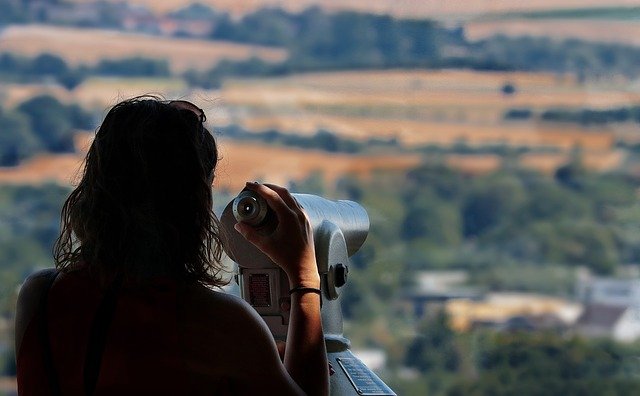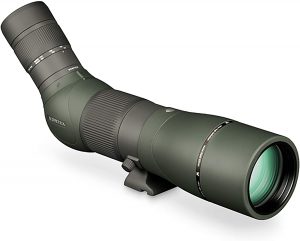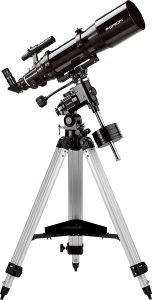Welcome to our article about spotting scopes vs telescopes! I will go through the similarities and differences between these two products a bit further down the article, but first, let’s discuss why you might want to consider one over the other to begin with.
Table of Contents
Spotting Scopes vs Telescopes – Introduction
If you love the outdoors and are looking for a way to broaden your perspective and zoom in on the detail around you, spotting scopes and telescopes are two of the most useful pieces of equipment you can invest in.
However, while they have the same basic function, there are a lot of differences between spotting scopes and telescopes that make each one suited to different applications.
Below I go through not only the pros and cons of spotting scopes and telescopes, but also the strengths of each and when you should use one over the other. Let’s get started.
Spotting Scopes vs Telescopes – A Quick Summary
If you want to quickly know the difference between spotting scopes and telescopes, here it is:
While both spotting scopes and telescopes magnify far away objects, spotting scopes are much better suited to outdoor activities such as hiking and birdwatching as they are light and portable. Telescopes are better suited to looking at the stars and planets as they offer much higher magnification than spotting scopes, but are heavy and difficult to move.
Detailed Reviews of Spotting Scopes and Telescopes
What is a Spotting Scope?
A spotting scope is a high-powered portable optical enhancement device typically mounted on a tripod. It is designed to provide the user with a detailed view of distant objects.
Uses for Spotting Scopes
Spotting scopes are mainly used for outdoor activities such as birdwatching, wildlife observation, and other nature activities, for hunting and target shooting to confirm shot placements, for tactical ranging and surveillance, and for other instances that require a more powerful magnification.
They can also be used in conjunction with certain types of cameras for long-distance picture taking, and for a little bit of astronomy, as well.
Pros
- Lightweight, compact, and portable
- Allows viewing of sensitive subjects such as deer from safe distances
- Enables you to focus on a specific animal among a herd
Cons
- Relatively expensive
- Higher magnifications render images unstable
What is a Telescope?
A telescope is an optical instrument that is equipped with an arrangement of lenses or curved mirrors that collect light rays to make distant objects appear nearer and larger.
Uses for Telescopes
Telescopes are designed to observe the moon and planets within our solar system and explore deep space objects. You can also use telescopes for astrophotography with the right accessories.
Pros
- Higher magnification = larger and clearer images
- Wider field of view
- Steadier images even in tough conditions
Cons
- Gives an inverted or upside-down view of objects
- Weak zooming capability
- Can be hard to transport because of its larger size and weight
Here are some important points to consider when deciding if a spotting scope or a telescope is right for you:
Magnification
The majority of spotting scopes, even with their zoom eyepieces, usually provide at most a 60x magnification. This magnification, however, still does not guarantee clear and sharp images as a spotting scope’s performance can easily be affected by air currents, dust particles, and heatwaves.
Telescopes, on the other hand, are specifically designed for high magnification and come in ranges from 120x to as much as 500x, which provides better image quality compared to spotting scopes, and allows you to see objects that are much further away. Increasing that power even more can be as easy as adding more attachments or eyepieces to your telescope.
Winner: Telescope
Configuration
Spotting scopes are available in 2 configurations: straight or angled viewing. A straight viewing scope is equipped with a prism that directs the light straight in line with the body of the scope, while an angled viewing scope features a prism that directs the light at a 45-degree angle.
Hikers, bird watchers and outdoor enthusiasts almost exclusively use the angled view, while hunters and shooters prefer the straight line mainly because of their angle to their target when lying on the ground.
Depending on the type of telescope, a right-angle viewing option is typically the norm, but most are designed to point skyward and not at terrestrial levels. The configuration of a telescope dictates its angular magnification, field of view, amount of light gathered, and mounting options.
There are many types of telescopes and factors such as aperture size, magnification, focal length, and eyepieces should always be kept in mind before choosing what type best suits an astronomer’s needs.
Winner: Tie
Image Orientation
All images that are viewed through spotting scopes, telescopes, and even cameras are inverted because that is the way lenses and mirrors work. Even the lenses in your eyes provide an inverted image of your surroundings which your brain then processes and corrects.
Spotting scopes are primarily designed in a way that their optical components are built to give you a right-way-up and right-way round image that you would normally see with your eyes. The prisms will flip the image and correct it before it reaches your eye. The “correction” is built-in.
Telescopes are designed mainly for astronomy, but present an image that is upside down and left to right. This is because telescope optics let in as much light as possible so that images are brighter, especially if viewing the night sky. To correct the upside-down image, additional optics such as a diagonal may be needed, but this can lead to less light and low image quality.
Usually, for frequent telescope users such as astronomers, it is not important whether an object is upside-down or right-side-up. The crucial thing is that everything is seen as clearly and brightly as possible. However, the upside down image is a point to keep in mind when deciding between the two, particularly if you are planning on using your telescope for more than just astronomy.
Winner: Spotting scope
Image Stability
Spotting scopes, with their lower magnification, typically provide more stable images. The problem, however, is that ambient environmental conditions easily affect the performance of a spotting scope, whether mounted on a tripod or handheld. Many spotting scope users observe that, at its highest magnification, images can be blurred and indistinct.
Telescopes need a tripod and most models come with a tripod included. The trouble is most of these included tripods are inferior in quality and useful only at table or bench height. They can sometimes be quite shaky and flimsy, resulting in an equally low image stability as the spotting scope.
With all this considered, neither optical device really wins at image stability. It comes down to how far away the object you’re trying to view is, the magnification setting you’ve got your device on, and how stable your tripod is.
Winner: Tie
Zoom
Zeroing in on your target with zoom magnification to get a detailed view is crucial for birdwatching, wildlife observation and hunting. Spotting scopes, with their variable power features, allow distant viewing at low power of approximately 20x and zooming in at anywhere from 60x to 100x for greater detail.
Telescopes are equipped with eyepieces that are attached to them and offering a high but fixed magnification. You can either change the eyepiece or add lens attachments if you want to zoom, however this is an extra hassle and expense.
Winner: Spotting scope
Close Focus
Spotting scopes are designed for terrestrial use and can provide amazingly detailed close-up views of objects as small as a butterfly perched on a flower or a hummingbird feasting on a bird feeder only a few feet away.
Telescopes are designed to view objects from thousands of miles away and have fairly limited close-focusing capability. Close-range objects tend to look blurred through a telescope.
Winner: Spotting scope
Versatility
Telescopes are not specifically designed for terrestrial viewing, and spotting scopes are not specifically designed for celestial viewing.
Of course, spotting scopes can be taken outdoors and used to look at the moon, planets, and the night time sky with adequate capabilities, and this would be easy enough because of the compact design and portability of spotting scopes. On the flip side, telescopes can be used to look at birds and wildlife, however it would be a bit awkward and difficult to bring a telescope during hunting or birding because of its larger and heavier design.
In addition, while many spotting scopes are designed for marine and outdoor use, most telescopes are not geared to withstand extreme weather and outdoor conditions, making them even more inappropriate for outdoor expeditions.
Photography is another area where spotting scopes and telescopes can both be used. Both devices need an adapter to connect to either a camera or a smartphone.
A spotting scope can work with a simple adapter that can cost as little as $10, whereas things are not so simple with a telescope. You need to consider additional factors such as the focal length, manual focus, exposure, and shutter shake before purchasing an adaptor to allow you to acquire high-quality pictures.
Winner: Spotting scope
Portability
Spotting scopes are designed to be small, lightweight, and portable. They are meant to be used in the field, and hence many models have tough “armors” around them to protect them from dust, water, and fog. Most of them are also shock-proof and rust-proof, with some higher-end brands equipped with see-through carrying cases, which lets you use them even without taking them out of the protective case.
Telescopes, especially the bigger ones, are usually contained in more than one box, and require assembly each time they need to be brought from one place to another. They are set up in such a way that they should remain in one place most of the time. They are not something you can take wherever and whenever you need to. They also tend to be more fragile than spotting scopes.
The most popular portable telescopes are refracting telescopes, the most compact of which is as light as 1.5 lbs and measures 17” long. This size can be ideal for backpacking or travel, but you pay the price in power, magnification, and optical quality. Telescopes that offer the best image quality are mainly heavy, large, bulky, and extremely fragile, making them not very good candidates for repeated transport, assembly, and disassembly.
Winner: Spotting scope
Durability
Spotting scopes, much like binoculars, are designed to be water, fog, and shock proof as their main use is in the field among birders, wildlife watchers, and hunters.
Telescopes are precision devices that tend to be more fragile. They are not really specifically outfitted for travel or rugged and extreme weather conditions.
Winner: Spotting scope
Ease of Use
The basic structure of spotting scopes and telescopes nowadays is that they are both user-friendly.
Spotting scopes, however, are mostly equipped with eyepieces that have zooming capabilities, enabling you to zoom in on a target once you have it in your sights. This feature allows your spotting scope to become some sort of a one-stop-shop kind of tool, everything in one neat little package.
Telescopes, on the other hand, require the use of different eyepieces when changing magnification. Switching these eyepieces out may not be that difficult, but it may be time-consuming and tedious. It also means that you need to carry more equipment which may be bothersome if you are on the go.
Both can be mounted on tripods, and spotting scopes can work just as well on camera tripods, but telescopes, especially the larger ones, will need a more specialized form of support.
Winner: Spotting scope
Price
As the old saying goes, you get what you pay for, however in the world of optics you can get incredible value at an affordable price.
If you’re a beginner, you can find extremely affordable spotting scopes and telescopes (both under $100) that will serve your purpose well, and I would recommend starting with these if you’re just starting out.
You can also find mid and high tier spotting scopes and telescopes that are a few hundred to a few thousand dollars. However, telescopes definitely out-run spotting scopes in the price that they go up to, with some of them valued at multiple thousands of dollars.
The price that you will pay for either one will depend on how much you use it and hence how much you’re willing to invest – but you can find great value for money with both spotting scopes and telescopes.
Winner: Tie
Which One Should You Choose?
If you will be spending most of your time on long-distance viewing such as astronomy, and portability is not a major concern, a telescope is the way to go. It’s primary purpose is for looking into the heavens and it provides exceptional performance when doing so.
If you tend to indulge in birdwatching, wildlife viewing, hunting, sports such as target shooting, archery, and golf, digiscoping and telephotography, and entry-level astronomy, a spotting scope is the best choice for you. It is also perfect if you are someone who likes to be able to just pack up in an instant and explore nature.
However, if money is not a problem and you enjoy looking at the stars as well as exploring nature, I recommend indulging in both! After all, there is nothing better than having the perfect tool for every one of your needs.
FAQs
Can You Use a Spotting Scope as a Telescope?
Yes, spotting scopes can be used as telescopes to some extent. However the magnification on a spotting scope is much lower than a telescope, making it more difficult for the spotting scope to provide clear, bright images of far away stars and planets.
Telescopes are specifically designed to look at the heavens, and will give you a crystal clear image of most celestial bodies. However, as mentioned above, they are also heavy and difficult to move.
If you want a device for the sole purpose of astronomy, definitely go for a telescope. However if you enjoy casually looking at the stars during camping trips or at other sporadic times, a spotting scope will be sufficient.
Is a Spotting Scope or a Telescope Better for a Child?
A spotting scope is usually the best choice for a child who is expressing an interest in birdwatching, outdoor exploring or even astronomy for the first time. It will be easier for them to handle with their small hands. In addition, if their interest wanes in one activity, they can still use the spotting scope for many other activities, saving you money on the investment!
If their interest in astronomy in particular persists, it may then be time to consider a telescope. Watching the moon, stars, and planets, especially at night time will be more satisfying with the right type of telescope, and a spotting scope in this scenario will always fall short.
Conclusion
I hope this article has helped you decide whether a spotting scope or a telescope is right for you! Click the links below to view spotting scopes and telescopes on Amazon:
View Spotting Scopes Here
View Telescopes Here
Here are some related articles you may also enjoy:
Best Scope for 1000 Yards
Best Scope for Elk Hunting

About The Author:
Hi! I’m Will Scott, the author of this post. I’m an outdoor enthusiast with over 10 years experience. I love trying out new gear and reviewing it so that other adventurers can get the most out of their experiences. I hope you’ve found my website informative, educational and helpful.



